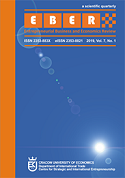Does Entrepreneurship Affect Income Inequality within Countries? Direct and Indirect Effects in European Countries
Does Entrepreneurship Affect Income Inequality within Countries? Direct and Indirect Effects in European Countries
Author(s): Aleksandra GawełSubject(s): Micro-Economics, Labor relations, EU-Approach / EU-Accession / EU-Development, Socio-Economic Research
Published by: Uniwersytet Ekonomiczny w Krakowie
Keywords: entrepreneurship; start-up rate; survival rate; employment share; income inequality; within inequality;
Summary/Abstract: Objective: The objective of the article is to verify the direct and indirect impact of entrepreneurship on income inequality within countries. Inequality has long been a problem for people, which appears as a consequence of unequal access to and distribution of wealth. The article implements the perspective of entrepreneurship into the discussion on inequality. Research Design & Methods: The research method is quantitative. Based on panel data of 26 European countries in years 2008-2018, regression functions are estimated to verify research hypotheses. Findings: The direct influence of entrepreneurship measured by birth rate, death rate, and survival rate on inequality seems to be quite limited. However, the most important relationship is indirect impact through employment creation, which seems to reduce income inequality, especially regarding the employment of surviving companies. Implications & Recommendations: The employment share of surviving companies is an important variable that reduces income inequality; the entrepreneurship policy should concentrate on supporting the survival of newly created companies, not just on the start-up process. Contribution & Value Added: The novelty of the article is to implement the distinction between direct and indirect impact of entrepreneurship. The process of new company creation affects not only incomes of entrepreneurs but most importantly the indirect reduction of income inequality through employment. Moreover, the article sheds new light on the matter of inequality by the incorporation of time lag into analyses.
Journal: Entrepreneurial Business and Economics Review
- Issue Year: 8/2020
- Issue No: 2
- Page Range: 93-110
- Page Count: 18
- Language: English

